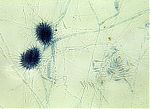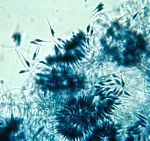Dipsacomyces
DIPSACOMYCES R.K. Benjamin, 1961 (Aliso 5:15); 1 sp. (Benjamin, 1961).
Sporangiophores septate, simple or branched, fertile region more or less straight. Sporocladia produced laterally from the fertile hyphae; they are not formed at the apex. Sporocladium multicelled, producing pseudophialides from one side. Merosporangia unicelled, long-ellipsoid, with an acuminate apex, one produced from each pseudophialide; released in a droplet of fluid at maturity. Zygospores unknown.
Type species: D. acuminosporus
Species of Dipsacomyces:
D. acuminosporus R.K. Benjamin, 1961 (Aliso 5:15) (Young 1968, 1999).
Sporulation of D. acuminosporus takes five to seven days and it may only occur in the colony in certain places and it usually proceeds from the bottom to the top of the fertile hyphae. Growth and sporulation are maximized when the fungus is inoculated on relatively nutrient-rich culture media. Dipsacomyces was isolated from soil; it is only known from the initial report. O’Donnell (1979) published four SEM photographs for D. acuminosporus.
Bibliography
Benjamin, R.K. 1961. Addenda to “The merosporangiferous Mucorales.†Aliso 5:11-19.
O’Donnell, K.L. 1979. Zygomycetes in Culture. Palfrey Contributions in Botany No. 2. Department of Botany, University of Georgia, Athens, Georgia.
Young, T.W.K. 1968. Electron microscopic study of the asexual structures in Kickxellaceae. New Phytologist 67:823-836.
Young, T.W.K. 1999. Taxonomy of Kickxellaceae and the radiation of the asexual apparatus. Kew Bull. 54:651-661.
Updated Feb 26, 2007


